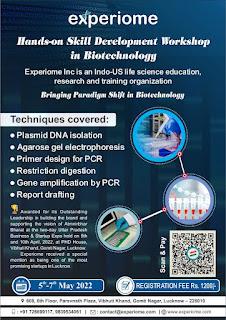Polymerase Chain Reaction (PCR) | Experiome Inc
Polymerase Chain Reaction (PCR)
An American biochemist named Kary B. Mullis invented PCR in 1983. Prior to the advent of
PCR, the process of amplifying, or making copies of, recombinant DNA fragments was time-
consuming and labor-intensive. The polymerase chain reaction (PCR), sometimes known as
"molecular photocopying," is a simple and inexpensive process for amplifying, or copying, small
pieces of DNA. Because molecular and genetic analyses require large amounts of DNA, studies
of isolated fragments of DNA are nearly impossible without PCR amplification. To amplify the
DNA segment in PCR, the template DNA is heated for its denaturation. Taq polymerase is an
enzyme that creates two new strands of DNA using the previous strands as templates. This
process causes the original DNA to be duplicated, with each new molecule comprising one old
and one new strand of DNA. Then, for each of these strands, two new copies can be made, and
so on. Denaturing and synthesizing new DNA is repeated 30 - 40 times, or 2 n times, resulting in
more than one billion exact duplicates of the original DNA segment. Thermal cycler is the
equipment which takes few hours to complete the entire process. The change of temperature
which allows DNA denaturation and synthesis is controlled in this thermocycler. Steps involved
in it are:
Denaturation: A thermal cycler is used to heat the fluid in the tube to at least 94°C (201.2°F).
Double stranded DNA is split into single stranded by the heat as the hydrogen bonds between
them are broken (this is termed denaturation of double-stranded DNA). Biotech Research Centre in Lucknow
Annealing: DNA primers and polymerase enzyme are cooled between 50 and 60 degrees
Celsius allowing the attachment to the different strands of DNA that were separated by the heat
(this is termed annealing of the primers). The individual split strands of DNA that emerged from
the heating procedure will be extended by nucleotides A, T, G and C. Short Term Biotechnology Training Centre in Lucknow
Extension: During this step the nucleotides are added to the primers to make the new strand
complementary to the template DNA. Each of the single strand of the original template DNA
molecule is used to create a new duplicate double-stranded DNA molecule. This step is
performed at the temperature 72 degrees Celsius.
Application of PCR includes:
1. Gene fragment amplification as a quick alternative to cloning.
2. The tinkering with DNA fragments.
3. The sensitive detection of pathogenic microorganisms, followed by precise genotyping if
desired.
4. Arachaeological specimen DNA analysis
5. Finding mutations that are linked to inherited disorders, cancer transformation, or tissue
typing.
6. Genetic marker analysis for forensic applications, paternity testing, and the mapping of
hereditary features.
7. Amplification of DNA segments between interspersed-repeat elements that is species-
specific.
8. Gene expression research.
At Experiome, we provide hands-on training in PCR on the gradient BioRad thermal cycler.
Visit Here-Biotech Training in Lucknow
Summer Training in Biotechnology and Bioinformatics in Lucknow

Comments
Post a Comment